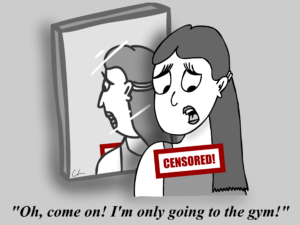Dress codes have been a hot button topic for the rising generation for almost as long as those who comprise it have been in school.
Many universities, while they may not have dress codes that overarch the entirety of campus, have dress codes that cover their gyms and recreational facilities. Northern Kentucky University, University of Wisconsin–Madison, the University of Kentucky and Western Kentucky University are all examples. NKU, UK and WKU don’t have policies quite as in-depth as the written policy you can find on the Wellness Center’s website, but they have them, nonetheless. UW Madison does indeed have one to the extent of Murray State’s Wellness Center, which covers footwear, shirts, pants and more that is and isn’t allowed.
Recently, the Susan E. Bauernfeind Wellness Center put up flyers depicting what and what not to wear at the gym. The flyers depicted mostly tank tops, some that were acceptable and some that had been deemed unacceptable.
 The Wellness Center has always had a dress code; Travis Rawe, director of campus recreation, said the staff of Wellness have enforced the dress code since the building was built.
The Wellness Center has always had a dress code; Travis Rawe, director of campus recreation, said the staff of Wellness have enforced the dress code since the building was built.
“Since there has only ever been written policies, there has been some confusion over the last couple of years over what is allowed and what isn’t,” Rawe said. “With this, we decided to find a graphic that is similar to what other universities use to show what is best to wear in a gym to lower the risk of infection and diseases.”
Risk of infection and diseases, Rawe said, is the entire reason behind the dress code in gyms and recreational centers.
Sweat is not hard to come by in a gym, with people working out and pushing their bodies to the limit. Sweat, while made almost entirely of water, can spread chemicals and bacteria that come from your body. It can also give bacteria that is already on the equipment an easier means of transport.
Rawe said the clothing that is off limits to gym-goers is clothing that leaves more of your body exposed, therefore exposing more of the machinery to your sweat. This increases the likelihood of the spread of germs and infection.
Upon seeing the flyers at wellness, many students were thrown back into their grade school days; students felt the dress code was labeling their bodies as “offensive,” and took to Twitter to voice their protests.
“Omg so sorry I didn’t realize my back is STILL offensive at almost 22 yrs old, I thought we could all be grown ups here,” tweeted Hannah Tomblinson, a Murray State student.
The comment section of Tomblinson’s tweet was full of students from all different schools stating their own views, some agreeing, some not.
The arguments ranged from questions of sexism to concerns about people acting like adults about the bodies of others. Some brought up the issues of sanitation.
Regardless of view, one thing is for sure: dress code is a controversial topic. If one is in place, people will be upset. If there isn’t one in place, people will be upset.
There is a case to be made for gyms having dress codes; safety and sanitation are both important ideas to take into consideration. Improper footwear worn during exercise can lead to long term damage to your body, not to mention the fall risk.
There is also something to be said about keeping the equipment sanitary, but just as there is the argument for a dress code to keep equipment clean, there is a rebuttal. Anyone who has been to a gym even once in their life knows that, once you use a piece of equipment, you are required to wipe that equipment down with the wet wipes provided to you by the facility.
And, at the end of the day, we, as university students and people over the age of 18, are adults. We have learned what is appropriate to wear in public. We have been taught how to respect the bodies of others, and if we don’t know how to respect others, then that is a problem that should be addressed on its own.
We are adults, and as such we are mature enough to make decisions all on our own.
Adults are also capable of understanding the necessity of sanitation and cleanliness. There is give and take to every situation.